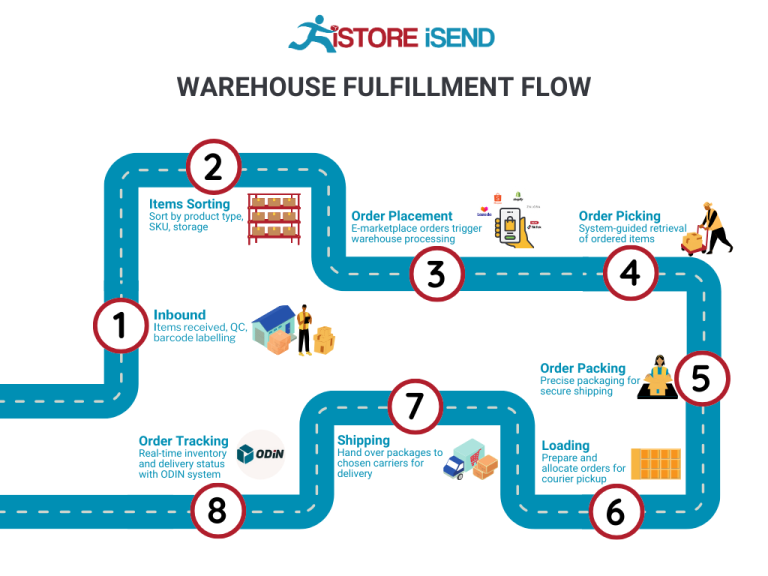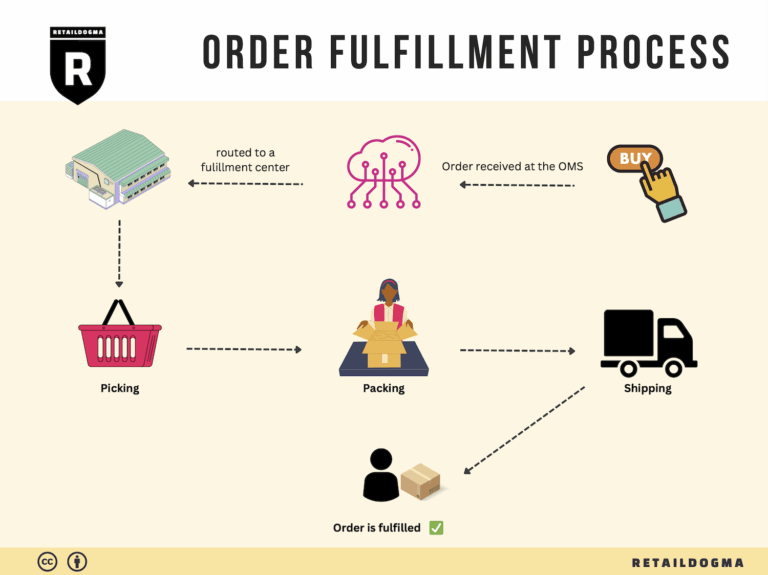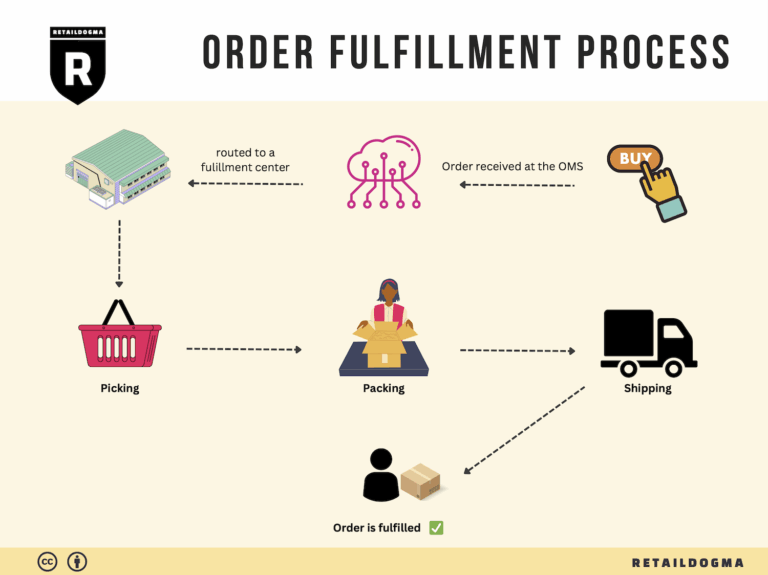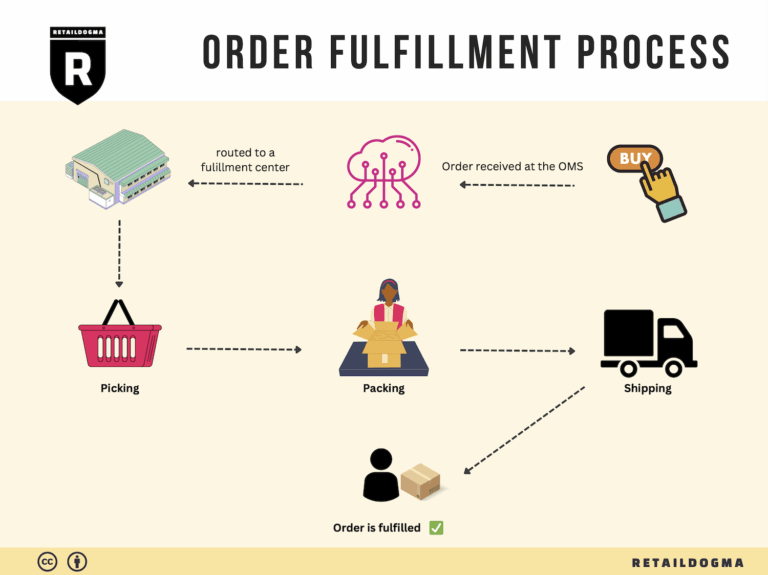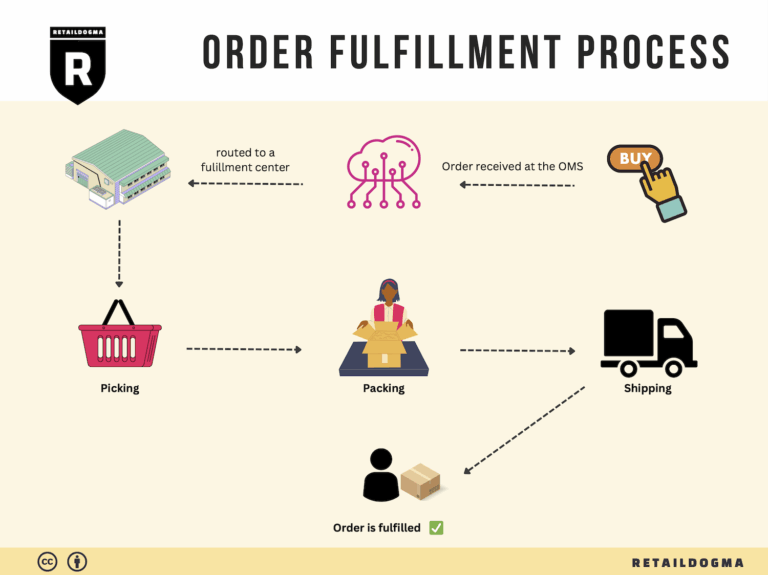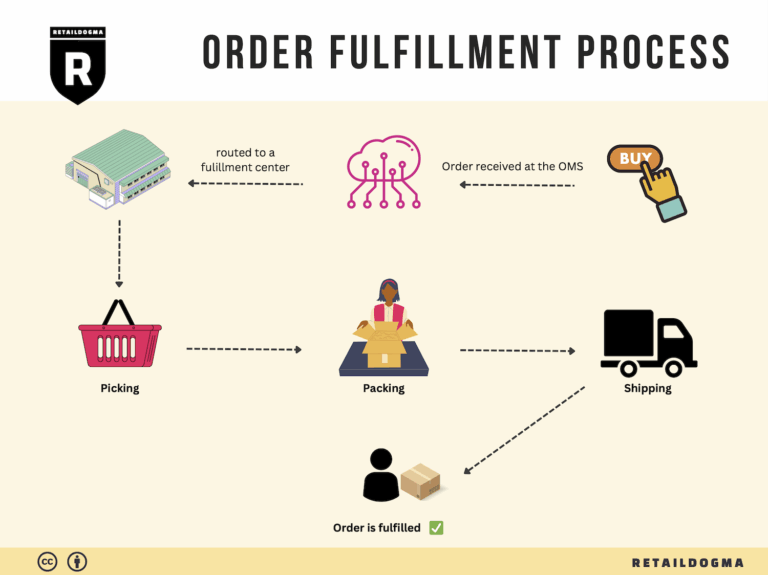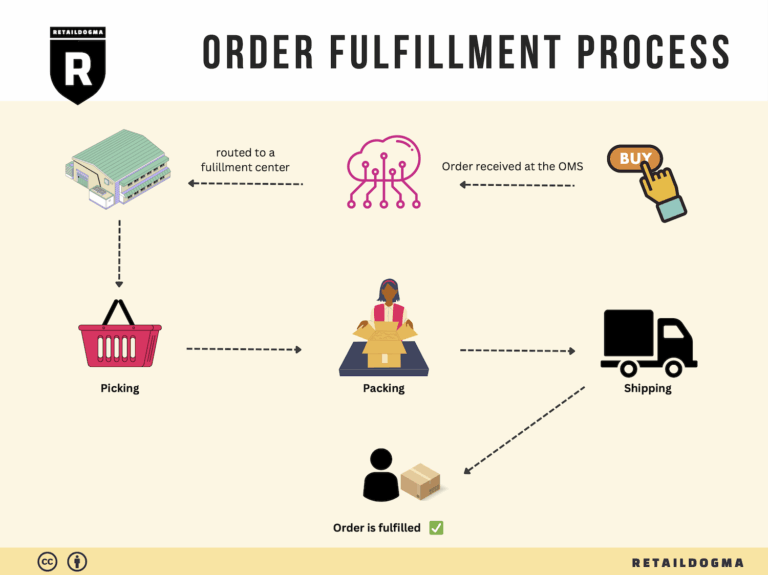What Is A Fulfillment Center? A Complete Guide (2025)
What is E-commerce Fulfillment? An Introduction for Growing Businesses
Understanding E-commerce Fulfillment
As a growing online business, you may find yourself grappling with the complexities of packing and shipping orders. This common pain point can overwhelm even the most organized entrepreneurs, diverting precious time and resources away from strategic growth. E-commerce fulfillment is essentially the backbone of your operations, encompassing the entire process of getting a product from your warehouse or fulfillment center to your customer’s doorstep.
In this guide, we will demystify e-commerce fulfillment by exploring various models such as Third-Party Logistics (3PL) and Fulfillment by Amazon (FBA). Each model offers distinct advantages and can significantly impact your overall efficiency and customer satisfaction. Understanding these options is crucial for making informed decisions that align with your business needs.
We will delve into the core services associated with fulfillment, including inventory management, order processing, packing, shipping, and customer service. Each of these components plays a vital role in ensuring that your customers receive their orders promptly and in excellent condition. Furthermore, we will provide insights into how to choose the right fulfillment partner, taking into account factors such as their technology stack, shipping capabilities, and customer support services.
Pricing is another critical consideration that can make or break your fulfillment strategy. We will break down the typical costs associated with different fulfillment models, helping you understand the trade-offs involved and how to budget effectively.
Ultimately, the goal of this guide is to empower your business with the knowledge needed to make smart logistics decisions. By optimizing your fulfillment processes, you can enhance customer satisfaction, reduce operational headaches, and focus on what truly matters: scaling your business. Whether you are just starting or looking to refine your existing operations, understanding the nuances of e-commerce fulfillment will position you for success in the competitive online marketplace.
What You’ll Learn In This Guide
- What is E-commerce Fulfillment? An Introduction for Growing Businesses
- The Order Fulfillment Process: From ‘Buy’ Button to Customer’s Door
- Comparing Fulfillment Models: In-House vs. 3PL vs. Dropshipping
- A Deep Dive into Amazon FBA: Pros, Cons, and Who It’s For
- Core Services Offered by Fulfillment Centers
- How to Choose a Fulfillment Partner: A 6-Point Checklist
- Understanding Fulfillment Pricing: A Breakdown of Common Fees
- Frequently Asked Questions (FAQs) about Fulfillment
- Conclusion: Is Outsourcing Fulfillment the Right Move for Your Business?
- Important Disclaimer
The Order Fulfillment Process: From ‘Buy’ Button to Customer’s Door
1. Receiving Inventory
The first step in the order fulfillment process is receiving inventory. This involves the acceptance of goods from suppliers at your micro-fulfillment center or warehouse. During this stage, each item is checked against purchase orders to ensure that the correct quantities and types of products have been received. This process often utilizes Stock Keeping Units (SKUs), which are unique identifiers assigned to each product, allowing for efficient tracking and management.
Receiving inventory is critical because it sets the foundation for all subsequent steps. Accurate receiving prevents stock discrepancies, which can lead to issues such as backorders or overstock situations. Any errors at this stage can cascade down the fulfillment chain, resulting in dissatisfied customers and increased operational costs. Implementing robust receiving procedures can also streamline inventory management, ensuring that products are readily available for order fulfillment.
2. Warehouse Storage
Once inventory has been received and accounted for, the next step is warehouse storage. This involves strategically placing products within the fulfillment center. The layout of the warehouse should be optimized for efficiency, often employing techniques like slotting, where high-demand items are placed closer to the packing and shipping areas to reduce retrieval time.
Effective warehouse storage is essential for maintaining an organized inventory system. It ensures that products can be quickly located and retrieved, minimizing the time taken to fulfill orders. Additionally, a well-organized storage system can reduce labor costs and enhance operational efficiency. Businesses should regularly evaluate their storage strategies and adjust based on product demand, seasonality, and sales trends.
3. Order Picking
Order picking is the process of retrieving items from storage to fulfill customer orders. This step typically involves creating pick lists, which are documents that outline the items and quantities needed for each order. Pickers use these lists to navigate the warehouse efficiently, often employing methods such as batch picking or zone picking to optimize the process.
The importance of order picking cannot be overstated; it directly impacts order accuracy and fulfillment speed. Errors during picking can lead to incorrect orders being shipped, which can harm customer satisfaction and increase return rates. To mitigate these risks, businesses should invest in training for staff, utilize technology such as barcode scanners, and consider automated picking systems to enhance accuracy and efficiency.
4. Order Packing
After items have been picked, they move to the order packing stage. This involves securely packaging the products to ensure they arrive at the customer’s doorstep in perfect condition. Effective packing techniques include using the right materials, such as boxes or padded envelopes, and employing dimensional weight pricing strategies to minimize shipping costs.
Packing is crucial for both customer satisfaction and cost efficiency. Properly packed orders help prevent damage during transit, reducing the likelihood of returns and refunds. Additionally, well-packed items can lead to lower shipping costs, as carriers often charge based on the weight and dimensions of packages. Businesses should also consider incorporating branding elements into their packaging to enhance the customer experience and promote brand loyalty.
5. Shipping & Delivery
The final step in the fulfillment process is shipping and delivery. Once orders are packed, they are labeled and prepared for shipment. This step involves selecting the appropriate shipping methods, which can vary based on factors such as delivery speed, cost, and customer preferences. With the integration of platforms like Gopuff, businesses can leverage instant delivery solutions that can get orders to customers in as little as 15 minutes.
Shipping and delivery are vital for customer satisfaction, as timely delivery can significantly impact the overall shopping experience. Efficient shipping processes can help businesses meet the growing consumer demand for quick and reliable delivery options. Additionally, real-time tracking systems can enhance transparency, allowing customers to monitor their orders from the moment they leave the warehouse until they arrive at their door. By optimizing shipping and delivery, businesses can build trust with their customers, encouraging repeat purchases and fostering long-term loyalty.
Comparing Fulfillment Models: In-House vs. 3PL vs. Dropshipping
Fulfillment Model Comparison
| Model | Who Handles Inventory | Best For (Business Stage) | Key Advantage | Key Disadvantage |
|---|---|---|---|---|
| In-House Fulfillment | The business itself | Established brands with stable sales | Complete control over inventory and fulfillment process | High overhead costs and resource-intensive |
| Third-Party Logistics (3PL) | A third-party logistics provider | Growing businesses scaling operations | Cost-effective and scalable solution | Less control over inventory and fulfillment speed |
| Dropshipping | Supplier or manufacturer | Startups and low-capital businesses | Minimal upfront investment and low risk | Lower profit margins and dependency on suppliers |
In-House Fulfillment
In-house fulfillment is a model where the business itself manages inventory, storage, packing, and shipping of products. This approach is often favored by established brands with stable sales and a strong customer base. The primary advantage of in-house fulfillment is the complete control it offers over the inventory and fulfillment process. Businesses can tailor their operations to meet specific customer needs, ensuring quality and consistency. They can also respond rapidly to changes in demand or inventory levels. However, this model comes with significant disadvantages, including high overhead costs associated with warehousing, staffing, and technology. The resource intensity required for in-house fulfillment can strain a company’s finances and operational efficiency, making it less suitable for startups or small businesses seeking to minimize risks.
Third-Party Logistics (3PL)
Third-party logistics (3PL) involves outsourcing fulfillment operations to a specialized logistics provider. This model is particularly beneficial for growing businesses that are looking to scale their operations without the burden of managing logistics themselves. A key advantage of using 3PL is the cost-effectiveness and scalability it offers. By partnering with a 3PL provider, businesses can leverage established infrastructure, technology, and expertise, allowing them to focus on core activities like marketing and product development. However, a notable disadvantage is the reduced control over inventory management and fulfillment speed. Businesses may experience delays or issues that are outside of their direct control, which can negatively impact customer satisfaction. Additionally, reliance on a third party means that any disruptions in their operations can directly affect the business’s performance.
Dropshipping
Dropshipping is a fulfillment model where the retailer does not keep products in stock but instead transfers customer orders and shipment details to a supplier or manufacturer, who then ships the products directly to the customer. This model is often favored by startups and entrepreneurs with limited capital, as it requires minimal upfront investment and carries low financial risk. One of the main advantages of dropshipping is the ability to offer a wide variety of products without the burden of managing inventory or warehousing. However, dropshipping also comes with its own set of challenges. Profit margins tend to be lower compared to other fulfillment models, as retailers must share profits with suppliers. Additionally, businesses are heavily dependent on the reliability and efficiency of their suppliers, which can lead to issues such as stock shortages, shipping delays, or quality control problems. This dependency can create a less-than-ideal customer experience, particularly for businesses that prioritize brand reputation and service quality.
Conclusion
Selecting the right fulfillment model is crucial for any e-commerce business aiming to scale effectively. In-house fulfillment provides control but at a higher operational cost, making it suitable for established brands. Third-party logistics offer a scalable solution, ideal for growing companies, but can lead to less control over the fulfillment process. Dropshipping presents an accessible entry point for startups, though it involves lower profit margins and dependency on suppliers. Each model has its own unique strengths and weaknesses, and understanding these can empower business owners to make informed decisions that align with their strategic objectives and market conditions.
A Deep Dive into Amazon FBA: Pros, Cons, and Who It’s For
Understanding Fulfillment by Amazon (FBA)
Fulfillment by Amazon (FBA) is a service provided by Amazon that allows e-commerce sellers to store their products in Amazon’s fulfillment centers. Amazon then takes care of the storage, packaging, and shipping of these products to customers. FBA also provides customer service and handles returns on behalf of the sellers. This service enables sellers to leverage Amazon’s vast logistics network and customer trust, allowing them to focus more on their core business activities.
How FBA Works
-
Registration and Setup: Sellers need to create an Amazon Seller account and sign up for FBA. Once registered, they can list their products and specify that they want to use FBA for fulfillment.
-
Shipping Products to Amazon: Sellers prepare their products and ship them to Amazon’s fulfillment centers. They must follow Amazon’s guidelines for packaging and labeling to ensure smooth processing upon arrival.
-
Storage and Management: Once the products are at Amazon’s warehouses, they are stored until sold. Amazon provides tools for sellers to manage inventory, including tracking stock levels and sales performance.
-
Order Processing: When a customer places an order, Amazon picks, packs, and ships the product directly to the customer. This process typically happens within 24 hours, ensuring fast delivery.
-
Customer Service and Returns: Amazon handles all customer inquiries and return requests related to FBA orders, providing a seamless experience for both sellers and customers.
Pros of Using FBA
1. Prime Eligibility
One of the most significant advantages of using FBA is that products become eligible for Amazon Prime. Prime members often prefer products that are Prime-eligible due to the free two-day shipping, which can significantly increase sales volume.
2. Customer Trust
Amazon has built a strong reputation for customer service and reliability. By using FBA, sellers can leverage this trust, as customers are more likely to purchase products fulfilled by Amazon. This can lead to higher conversion rates compared to non-FBA listings.
3. Multi-Channel Fulfillment
FBA is not limited to sales on Amazon alone. Sellers can use FBA to fulfill orders from other sales channels, such as their own websites or other marketplaces. This multi-channel fulfillment capability allows businesses to streamline their logistics and manage inventory more effectively.
4. Scalability
FBA is designed to support businesses of all sizes. Whether you are a small startup or an established brand, FBA can scale with your business. As order volume increases, Amazon’s infrastructure can handle the increased demand without requiring sellers to invest in their logistics.
5. Time Savings
By outsourcing fulfillment to Amazon, sellers can save valuable time that can be redirected to other areas of their business, such as product development, marketing, and customer engagement. Amazon’s efficient logistics and customer service allow sellers to focus on growth.
Cons of Using FBA
1. High Fees
While FBA offers many advantages, it comes with various fees that can eat into profit margins. These fees include storage fees for products stored in Amazon’s warehouses and fulfillment fees for each order shipped. Sellers must carefully calculate these costs to ensure they remain profitable.
2. Strict Inventory Rules
Amazon has strict guidelines regarding inventory management. Sellers must adhere to these rules, including maintaining appropriate stock levels and ensuring that products are not expired or damaged. Failure to comply can lead to penalties or even account suspension.
3. Commingling Risks
FBA operates on a commingling model, where products from different sellers may be stored together in the same warehouse. This can pose risks for sellers, particularly if a customer receives a defective product from another seller’s inventory. Sellers may be held accountable for returns or negative feedback related to these issues.
4. Limited Control Over Fulfillment
When using FBA, sellers relinquish control over the fulfillment process. This means they cannot directly oversee packaging, shipping, or customer service, which may lead to inconsistencies in branding or customer experience.
5. Dependency on Amazon
By using FBA, sellers become dependent on Amazon’s policies and performance. Changes in Amazon’s algorithms, fee structures, or fulfillment policies can significantly impact a seller’s business.
Who is FBA Best For?
Fulfillment by Amazon is particularly well-suited for:
-
New Sellers: Entrepreneurs who are just starting their e-commerce journey can benefit from Amazon’s vast infrastructure and customer base, minimizing the complexities of logistics and fulfillment.
-
Small to Medium-Sized Businesses: Companies that are looking to scale quickly without investing heavily in their logistics can leverage FBA to meet growing demand.
-
Brands with High Volume Sales: Established brands with a proven sales history can utilize FBA to maximize efficiency and capitalize on Amazon’s Prime membership benefits.
-
Multi-Channel Sellers: Brands that sell across multiple platforms can streamline their operations and maintain consistent fulfillment standards by using FBA for various sales channels.
-
Businesses Focused on Customer Experience: Companies that prioritize excellent customer service and fast delivery can enhance their offerings by utilizing FBA’s logistics and support capabilities.
In conclusion, Fulfillment by Amazon offers a compelling solution for e-commerce businesses looking to streamline their operations and reach a broader audience. While it presents certain challenges, the benefits, especially in terms of speed, trust, and scalability, make it a valuable option for many sellers.
Core Services Offered by Fulfillment Centers
Inventory Management & Warehousing
Inventory management and warehousing form the backbone of any successful e-commerce operation. Fulfillment centers provide specialized storage solutions that help businesses maintain optimal inventory levels without the burden of managing a physical warehouse. This service involves systematic tracking of stock levels, product categorization, and inventory forecasting.
Benefits:
-
Real-Time Tracking: Fulfillment centers use advanced inventory management systems that offer real-time data on stock levels, which helps businesses avoid stockouts or overstock situations. This visibility allows for more informed purchasing decisions and inventory planning.
-
Space Optimization: By utilizing a fulfillment center, e-commerce businesses can free up valuable warehouse space. This is particularly beneficial for small to mid-sized companies that may not have the resources to maintain a large inventory on-site.
-
Cost Efficiency: Outsourcing warehousing to a fulfillment center can significantly reduce overhead costs associated with property leases, utilities, and staffing. This allows businesses to allocate funds toward marketing, product development, or other growth initiatives.
-
Scalability: As your business grows, fulfillment centers can easily accommodate increased inventory needs without the hassle of relocating or expanding your physical space. This flexibility is crucial for companies experiencing seasonal fluctuations or rapid growth.
Pick and Pack Services
Pick and pack services are essential for ensuring that orders are accurately fulfilled and shipped promptly. This process involves selecting items from the warehouse (picking) and then packing them for shipment (packing). Fulfillment centers employ trained staff and optimized systems to streamline this process, ensuring that orders are processed quickly and efficiently.
Benefits:
-
Speed and Accuracy: Fulfillment centers use sophisticated picking technologies, such as barcode scanners and automated systems, to minimize errors and increase the speed of order processing. This leads to higher customer satisfaction due to faster delivery times and accurate orders.
-
Professional Handling: Experienced fulfillment staff are trained in efficient picking and packing techniques, which reduces the risk of damage during transit. Proper packaging also enhances the unboxing experience for customers, reinforcing brand loyalty.
-
Custom Packaging Options: Many fulfillment centers offer customizable packaging solutions, allowing businesses to create branded packaging that can enhance the customer experience and foster brand recognition.
-
Order Volume Flexibility: Whether you have a surge in orders during peak seasons or a consistent volume, fulfillment centers can adjust their operations to meet your needs. This adaptability ensures that you can manage fluctuating demand without compromising service quality.
Kitting and Assembly
Kitting and assembly services involve grouping individual items into ready-to-sell sets or kits. This can include assembling products, creating promotional bundles, or preparing customized orders. Fulfillment centers can handle complex assembly tasks that require precision and efficiency.
Benefits:
-
Enhanced Product Offerings: Kitting allows e-commerce businesses to offer unique product bundles that can attract customers and increase average order value. For example, a beauty brand could bundle skincare products into a complete regimen, appealing to consumers looking for convenience.
-
Time Savings: By outsourcing kitting and assembly, businesses can save valuable time and labor costs. This allows internal teams to focus on core activities such as marketing and customer service rather than manual assembly tasks.
-
Quality Control: Fulfillment centers often implement quality control measures during the kitting process, ensuring that assembled products meet the required standards before shipment. This reduces the likelihood of returns due to assembly errors.
-
Inventory Management: Kitting can also help streamline inventory management by consolidating multiple products into one SKU. This simplification can lead to more efficient stock management and easier forecasting.
Returns Management (Reverse Logistics)
Returns management is a critical aspect of e-commerce operations, particularly in today’s consumer-driven marketplace where return rates can be as high as 30%. Fulfillment centers offer reverse logistics services that help businesses efficiently process returns, manage inventory, and minimize losses.
Benefits:
-
Streamlined Return Processes: Fulfillment centers can automate the returns process, making it easier for customers to return items. This can include providing return labels, tracking returns, and updating inventory levels in real-time.
-
Customer Satisfaction: A smooth and hassle-free returns process enhances the overall customer experience. When customers know they can return products easily, they are more likely to make a purchase, knowing that there is a safety net in place.
-
Inventory Recovery: Efficient returns management allows businesses to quickly assess returned items and determine whether they can be restocked or need to be discarded. This helps recover lost revenue and maintain optimal inventory levels.
-
Data Insights: Fulfillment centers can provide valuable insights into return trends and reasons, enabling businesses to make informed decisions about product quality, customer preferences, and inventory management strategies. This data can be crucial for improving product offerings and reducing future return rates.
In summary, partnering with a fulfillment center provides e-commerce businesses with a robust infrastructure that supports growth, enhances customer satisfaction, and optimizes operational efficiencies. By leveraging these core services, businesses can focus on scaling their sales while leaving the complexities of logistics to the experts.
How to Choose a Fulfillment Partner: A 6-Point Checklist
Location & Warehouse Network
The geographical location of your fulfillment partner’s warehouses plays a pivotal role in your shipping efficiency and costs. A partner with a well-distributed network of warehouses can significantly reduce shipping times and expenses, especially for businesses looking to provide fast delivery options.
Why It’s Important:
Having fulfillment centers located near your customer base can lead to quicker delivery times, which is crucial in today’s e-commerce landscape where consumers increasingly expect rapid service.
Questions to Ask:
– Where are your warehouses located, and how do these locations align with my primary customer demographics?
– Can you provide insights into your shipping zones and average delivery times for various regions?
– Do you have a plan for expanding your warehouse network to accommodate future growth?
Technology & Integrations
In the digital age, the technology stack of your fulfillment partner can make or break your logistics operations. A partner that offers robust technology solutions can streamline your order processing, inventory management, and shipping operations.
Why It’s Important:
Effective technology integration allows for real-time inventory updates, order tracking, and seamless communication between your e-commerce platform and the fulfillment center. This ensures a smooth customer experience and reduces the likelihood of errors.
Questions to Ask:
– What software and systems do you use for inventory management and order processing?
– How do you integrate with e-commerce platforms like Shopify, WooCommerce, or Magento?
– Can you provide examples of how your technology has improved efficiency for your other clients?
Specializations (e.g., cold storage, oversized items)
Different products require different handling and storage conditions. If your business deals with specialized items, such as perishables or oversized goods, it’s essential to choose a partner that can meet those specific needs.
Why It’s Important:
Specialized fulfillment capabilities ensure that your products are stored and handled correctly, maintaining their quality and compliance with regulations. This is particularly important for industries like food and beverage, pharmaceuticals, or high-value electronics.
Questions to Ask:
– What types of specialized fulfillment services do you offer (e.g., cold storage, hazardous materials, oversized items)?
– How do you ensure compliance with industry regulations for specialized products?
– Can you share any case studies where you successfully managed specialized fulfillment needs?
Scalability & Capacity
As your business grows, your fulfillment needs will evolve. Selecting a partner that can scale with you is critical to maintaining efficiency and meeting customer demands without disruption.
Why It’s Important:
A scalable fulfillment partner can adapt to fluctuations in order volume, seasonal spikes, and long-term growth, preventing bottlenecks that can lead to delays and dissatisfied customers.
Questions to Ask:
– How do you handle fluctuations in order volume, especially during peak seasons?
– What is your maximum capacity for storage and order fulfillment?
– Can you provide a plan for how you would support my business’s growth over the next few years?
Pricing and Contracts
Understanding the pricing structure and contract terms of your fulfillment partner is essential for budgeting and financial planning. Transparency in pricing helps prevent unexpected costs that can erode your profit margins.
Why It’s Important:
A clear pricing model allows you to accurately project costs and assess the financial viability of the partnership. Additionally, favorable contract terms can provide flexibility as your business evolves.
Questions to Ask:
– Can you provide a detailed breakdown of your pricing structure, including storage fees, pick-and-pack fees, and shipping costs?
– Are there any hidden fees or costs I should be aware of?
– What are the terms of the contract, and how do you handle contract renewals or cancellations?
Customer Support & Reviews
Reliable customer support is vital for resolving issues quickly and maintaining a positive relationship with your fulfillment partner. Additionally, reviews and testimonials can offer insights into the partner’s performance and reliability.
Why It’s Important:
Strong customer support ensures that any issues that arise are addressed promptly, minimizing disruptions to your operations. Positive reviews can also indicate a partner’s reputation and reliability in the industry.
Questions to Ask:
– What customer support options do you offer (e.g., phone, email, chat)?
– How do you handle issues such as order errors, inventory discrepancies, or shipping delays?
– Can you provide references or case studies from current or past clients?
By using this checklist, e-commerce business owners and operations managers can systematically evaluate potential fulfillment partners, ensuring that they select one that aligns with their operational needs and growth objectives. Choosing the right fulfillment partner is not just about logistics; it’s a strategic decision that can significantly impact customer satisfaction and business success.
Understanding Fulfillment Pricing: A Breakdown of Common Fees
Initial Setup Fees
Initial setup fees are charges associated with getting your account established with a fulfillment provider. These fees can vary widely depending on the complexity of your operations and the fulfillment service you choose. Typically, this fee covers the following:
- Account Creation: This includes the administrative work required to set up your account in the provider’s system.
- Integration Costs: Depending on your existing technology stack, there may be additional costs for integrating your e-commerce platform with the fulfillment provider’s systems. This could involve connecting APIs or adapting your online store to facilitate seamless order processing.
- Training: Some providers offer training sessions for your staff to familiarize them with the fulfillment process and software.
To calculate these fees, inquire specifically about their structure and what is included, as some providers may offer promotional waivers or discounts for new clients.
Receiving Fees
Receiving fees are incurred when your products arrive at the fulfillment center. These fees generally cover the costs associated with unloading, inspecting, and entering your inventory into the system. Here are the key components:
- Per Unit Charges: Many fulfillment centers charge a fee per unit received. This fee can vary based on the size and weight of the items.
- Minimum Charges: Some providers may have a minimum fee for receiving shipments, regardless of the number of items.
- Additional Handling: If your products require special handling (e.g., fragile items or bulk shipments), additional fees may apply.
When calculating receiving fees, consider the volume of inventory you plan to ship and any special requirements that may affect handling.
Storage Fees (per pallet/bin)
Storage fees are charged for the space your inventory occupies within the fulfillment center. This fee can be calculated based on several factors:
- Type of Storage: Most providers charge based on the type of storage used (pallets, bins, shelves). Pallet rates are typically higher due to the larger space they occupy.
- Duration of Storage: Fees can also be calculated on a monthly basis, meaning the longer you store your products, the more you will pay.
- Seasonal Adjustments: Some fulfillment centers implement higher fees during peak seasons (e.g., holiday seasons) due to increased demand for storage space.
To estimate your storage fees, keep track of your inventory turnover rates and plan accordingly to minimize costs.
Pick & Pack Fees (per item/order)
Pick and pack fees are charged for the labor involved in selecting items from inventory and packing them for shipment. This fee structure can include:
- Per Item Charges: Most fulfillment centers charge a fee for each item picked and packed. This fee can vary based on the complexity of the packing process.
- Order Complexity: If an order contains multiple items, some providers may charge additional fees for each additional item after the first.
- Special Packaging: If your products require special packaging or labeling, expect to pay extra for these services.
To effectively manage pick and pack fees, streamline your product offerings and minimize the number of unique items per order when possible.
Shipping Fees
Shipping fees represent the costs incurred to deliver your products to customers. These fees can be influenced by multiple factors:
- Carrier Rates: Costs vary based on the shipping carrier you choose (e.g., FedEx, UPS, USPS) and the shipping method (standard, expedited).
- Distance: Shipping costs typically increase with the distance between the fulfillment center and the customer’s delivery address.
- Weight and Dimensions: Heavier or larger packages generally incur higher shipping costs, so it’s essential to accurately measure and weigh your products.
When assessing shipping fees, consider negotiating rates with carriers and exploring fulfillment partners that offer competitive shipping options.
Tips for Getting an Accurate Quote
- Detailed Inventory List: Provide a comprehensive list of products, including dimensions and weights, to help fulfillment providers give you a precise quote.
- Volume Projections: Share your projected order volumes and frequency to allow providers to offer scalable pricing options.
- Ask About Hidden Fees: Inquire specifically about any additional fees that may not be included in the initial quote, such as returns processing or special handling.
- Request a Breakdown: Ask for a detailed breakdown of all fees involved in the fulfillment process to understand how costs are structured.
- Negotiate Terms: Don’t hesitate to negotiate terms based on your expected growth and order volume, as many providers are willing to offer discounts for long-term partnerships.
By understanding these common fees and how they are calculated, e-commerce business owners can make informed decisions and optimize their fulfillment strategies effectively.
Frequently Asked Questions (FAQs) about Fulfillment
1. What is a Gopuff micro-fulfillment center?
A Gopuff micro-fulfillment center is a small-scale warehouse strategically located within urban areas to enable rapid order fulfillment. These centers are designed to store a variety of consumer packaged goods (CPG) and facilitate delivery to customers in as little as 15 minutes, leveraging Gopuff’s established logistics network.
2. How does Gopuff’s fulfillment process work?
When a customer places an order through a Shopify store using the Gopuff Fulfillment App, the order is routed to the nearest micro-fulfillment center. Products are picked, packed, and delivered by Gopuff’s logistics team, ensuring a seamless and quick delivery experience directly from the online store to the customer.
3. What’s the difference between a warehouse and a fulfillment center?
A warehouse is primarily used for storage of goods until they are needed, often involving bulk inventory management. In contrast, a fulfillment center focuses on order processing, packing, and shipping. Fulfillment centers are equipped to handle the logistics of e-commerce orders, enabling faster delivery and improved customer service.
4. What is a 3PL (Third-Party Logistics)?
A 3PL is a service provider that manages a company’s logistics operations, including warehousing, inventory management, and shipping. By outsourcing these functions to a 3PL, businesses can focus on their core competencies while leveraging the 3PL’s expertise, technology, and infrastructure to enhance operational efficiency.
5. How much do fulfillment services cost?
Costs for fulfillment services can vary widely based on factors such as order volume, product type, storage space, and specific service offerings. Generally, fees can include storage fees, picking and packing fees, shipping costs, and additional charges for special handling. It’s essential for businesses to evaluate their specific needs and compare pricing models from different providers, including Gopuff, to find the best fit.
6. Can I use Gopuff’s fulfillment services if not all my products are available through Gopuff?
Yes, the Gopuff Fulfillment App allows you to create a special collection of products available for delivery through Gopuff. This means you can still sell products not in Gopuff’s catalog without disrupting your existing operations.
7. How does Gopuff handle orders when a customer is outside the delivery zone?
If a customer is outside the designated Gopuff delivery area, the Gopuff Fulfillment App will not display any instant delivery options or messaging. Your Shopify store will continue to operate normally, providing customers with standard shipping options as usual.
8. What customer service responsibilities does Gopuff handle?
Gopuff manages all customer service interactions related to fulfillment, such as issues with delivery times, damaged goods, or order cancellations. Customers can reach out directly to Gopuff’s support team, while product-related inquiries will be directed back to your website for assistance.
9. Does Gopuff support subscription services?
Yes, Gopuff supports subscription services with specific requirements. The subscription app must create recurring orders during Gopuff’s operating hours, and it should be able to revert to standard shipping if instant delivery is unavailable. This allows businesses to provide an excellent initial order experience while managing subsequent orders effectively.
10. What technology is required to integrate Gopuff’s services into my Shopify store?
Integrating Gopuff’s fulfillment services requires downloading and installing the Gopuff Fulfillment App from the Shopify App Store. The setup process is user-friendly and does not require any coding changes, enabling businesses to promote instant delivery on their websites quickly and efficiently.
Conclusion: Is Outsourcing Fulfillment the Right Move for Your Business?
Evaluating the Benefits of Outsourcing Fulfillment
Outsourcing fulfillment can be a game-changer for e-commerce businesses looking to scale efficiently. One of the most significant advantages is time savings. By leveraging a fulfillment partner, you can offload the complexities of inventory management, order processing, and shipping logistics. This allows your team to focus on core business strategies, such as marketing and product development, ultimately driving growth.
Scalability is another critical factor. As demand for your products fluctuates, a proficient fulfillment service can adjust operations to meet those needs without the hassle of hiring additional staff or investing in infrastructure. This flexibility enables you to respond rapidly to market changes, ensuring that you never miss an opportunity to capitalize on consumer trends.
Furthermore, partnering with an experienced fulfillment provider grants you access to specialized expertise and technology. Companies like Gopuff offer a robust logistics network and sophisticated platforms that streamline the fulfillment process, ensuring fast and reliable delivery. This not only enhances the customer experience but also improves operational efficiency, giving you a competitive edge in the fast-paced e-commerce landscape.
However, choosing the right fulfillment partner is paramount to your success. Not all services offer the same capabilities or align with your business goals. It’s essential to conduct thorough research and evaluate potential partners based on their technology, customer service, and ability to scale with your business.
Take Action
To determine if outsourcing fulfillment is the right next step for your business, consider conducting an audit of your current shipping processes. Identify areas of inefficiency and potential bottlenecks, and assess whether a fulfillment partner could enhance your operational capabilities. By taking this proactive approach, you can make informed decisions that will position your business for sustainable growth.
Important Disclaimer
⚠️ Important Disclaimer
The information in this guide is for educational purposes. Fulfillment services, pricing, and platform features change frequently. Always conduct your own due diligence and consult with providers directly before making business decisions.
